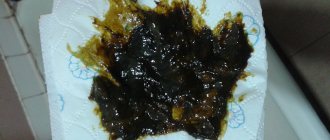During certain cycles, representatives of the fairer sex may notice that they have pink discharge after menstruation. Some people immediately begin to worry, others go to see a doctor, and some don’t pay attention to them at all. The latter option in relation to one’s health is unacceptable, since such a symptom often indicates the development of diseases.
If, a week after your period, pink discharge replaces normal leucorrhoea, it means that it can be assumed that a certain amount of blood is present in the biological fluid. In such situations, special attention should be paid to the accompanying symptoms, and if they are alarming, a thorough examination will be required. Let's look at what is considered normal, why there is pinkish discharge after menstruation, and when it is dangerous.
In most cases, women with normal health of the reproductive system, after regular bleeding has completed, smear after menstruation. Pink discharge is rare, often transparent and practically without any shade. Gradually, the level of estrogen in the body increases, the amount of mucus becomes large, and its consistency is liquid.
You can determine whether a woman is healthy by her periods. Source: navolne.life
After menstruation, pink discharge may last for no more than two days, and this condition will not be considered pathological. Doctors often answer women who come with such a complaint that this is due to a decrease in the blood’s ability to clot. This also does not rule out a deterioration in the contractile function of the uterus if there is stagnation of menstrual fluid.
Therefore, if pink discharge appears after menstruation, it can be judged that this is not considered a deviation if it lasts no more than two days. Provided that there is no foreign unpleasant odor, there are no clots or discomfort. After menstruation, pink, odorless discharge disappears on the third day, and by the middle of the cycle it becomes protein-like.
Causes
When pink discharge appears in women, the reasons for its occurrence after menstruation can be different. They depend on age, the presence or absence of concomitant pathologies, and recent treatment. Sometimes this happens when uterine tone increases and blood circulation in the reproductive organ improves.
Light pink discharge after menstruation may be the result of the following effects:
- The woman was actively involved in sports, lifted weights, and was involved in work with increased physical activity;
- Immediately before the cessation of menstruation, 1-2 days there was intimacy;
- Pale pink discharge after menstruation occurs when visiting a bathhouse, sauna, hot bath, or after being under the sun;
- Pink spotting after menstruation appears in representatives of the fairer sex who, during the period of discharge, took medications that have the ability to thin the blood;
- Recently, the girl suffered severe stress or took alcoholic beverages.
All the described conditions can have a certain effect on the woman’s body in general, and the reproductive system in particular, which is why pink discharge appears after menstruation a few days later. But there are other reasons that are also worth considering.
Ovulation
Most women wonder why there is pink discharge after menstruation. It all depends on the period in which they appeared. For example, the occurrence of such a symptom during the period of ovulation is not considered a deviation. The egg matures and leaves the follicle on about 10-15 days, injuring the vessels, so sometimes bleeding occurs.
The secretion of a secretion with such characteristics is short-lived. It is worth saying that scanty pink discharge in women after menstruation may go unnoticed. However, if pregnancy is planned, then this condition indicates the arrival of the most favorable day for conception.
Drugs
When pink discharge occurs after menstruation, a gynecologist can determine what it is. It is possible that this symptom is the body’s reaction to taking drugs with a contraceptive effect, or hormonal medications. In this case, you need to wait until the body adapts. If the adjustment period is completed, it is recommended to change the medication.
Intimacy
If girls notice pink discharge after menstruation, why they appear is the first thing they are interested in. There is a high probability of such a symptom occurring after active sexual intercourse. If the mucous membrane of the reproductive organ has been injured. This condition occurs when there is insufficient production of lubricating mucus, which leads to vaginal dryness.
Climax
Pink discharge at the end of menstruation occurs in women of menopausal age, in whom sex hormones are still being produced and bleeding, although not regular, is still present. The appearance of an atypical shade is also associated with vaginal dryness. But you should definitely visit a gynecologist, because at this age there is a high risk of developing gynecological diseases and tumors.
https://youtu.be/tJDtKZk0v5E
Pale pink discharge after period
Some representatives of the fairer sex may experience light pink mucous discharge at the end of menstruation or brown-pink discharge with clots a week later. The described phenomena are acceptable, provided there is no unpleasant odor or pain.
Often on women's forums they discuss the question of why pale pink discharge and itching are observed after menstruation. Symptoms indicate an inflammatory process or infection of the genital tract, the manifestation of which intensifies in the postmenstrual period.
In children
When a girl’s body is preparing for the onset of menstruation, about one year before the start of regular bleeding, she will develop leucorrhoea, which will have a characteristic slight yellowish tint. Since rapid fluctuations in hormonal levels are observed during the maturation of follicles, after the first bleeding ends, you will notice pink-brown discharge after menstruation.
This condition is considered normal and natural, since the body is under stress. The entire adaptation period can take up to two years, during which menstruation will occur with various deviations, but this will not indicate a disruption in the functioning of the reproductive system.
During the first few months of bearing a child, a girl may experience so-called false menstruation. They often appear as scanty brownish discharge. They do not pose a danger if their volume does not increase and there is no pain. This indicates a peculiar restructuring of the body and changes in hormonal levels.
After childbirth
Pink discharge in women after menstruation can be observed during breastfeeding. It must be said that the period of restoration of cycle regularity after the birth of a child depends on many factors. If natural feeding is performed, then menstruation may be absent for a year.
When feeding a baby with formula, bleeding occurs after a month and a half. We can definitely say that the nature of these secretions will differ from those that were before labor, since the period of bearing a child was accompanied by stretching of the reproductive organ, and after fulfilling its function it began to return to its previous size.
Pink discharge with an unpleasant odor after menstruation should definitely alert you, especially if it is accompanied by itching and burning in the genitals. This may indicate that the birth canal has become infected and a pathological process is developing that needs to be stopped.
Causes of pink discharge
The reasons for the appearance of pinkish discharge are quite varied and can be either natural or pathological. Only a competent specialist can make an accurate diagnosis. In order not to sound the alarm ahead of time, it is important to know which accompanying signs are acceptable and which indicate a problem.
Hormones and OK
Basically, such secretion is due to the course of the menstrual cycle and a shift in hormonal balance.
Light pink discharge is observed at the peak of the female hormone estrogen.
It has an enhanced effect on the lining of the uterus so that it is ready to receive a fertilized egg. This moment is identified with ovulation and is characterized by pale pink mucous secretion.
Pink mucous discharge may be a result of taking hormonal contraceptives that change the balance of estrogen and progesterone, or the installation of an intrauterine device. In this case, you should contact your doctor to adjust your medication regimen or select other means of contraception.
Pregnancy
Early pregnancy causes this symptom due to hormonal changes occurring in the woman’s body.
Allergy
An allergic reaction to medications, intimate hygiene products, or synthetic underwear can cause pink, watery discharge. This explains the appearance of pink vaginal discharge in girls who have not reached reproductive age.
Rehabilitation period
Unusual bright pink discharge, not associated with the course of the menstrual cycle, can be the result of gynecological and surgical manipulations, as a result of which the integrity of the tissues of the uterus or vagina was damaged.
Even long-healed wounds often make themselves felt with pinkish drops on the underwear. This phenomenon is characteristic of the rehabilitation period after medical, vacuum abortion, curettage, cleaning, biopsy and even a gynecological examination.
Injuries
Intense and rough sex, insufficient lubrication from the partner can affect the occurrence of the symptom. Sometimes lubricants irritate the vaginal mucosa, and the mechanical impact on it damages small blood vessels.
Infections and bacteria
If you begin to observe white or yellow-pink discharge with an unpleasant odor, curd-like pink discharge, itching and burning in the intimate area, pain when urinating, then such symptoms indicate genitourinary disorders.
Menopause
It is worth paying attention to this sign during menopause. If it was discovered before menopause, then this phenomenon is acceptable; if after, then it is necessary to carry out diagnostics. Perhaps we are talking about neoplasms in the tissues of the female organs.
Pathologies
Sometimes the occurrence of such discharge may indicate that a woman is developing a complex and dangerous disease of the reproductive organs or that the functioning of the reproductive system is being disrupted. To be sure of this and decide to go to a specialist, you need to pay attention to the presence of some alarming symptoms.
The development of pathology is indicated by:
- Change in the color of the discharge, which becomes bright red or burgundy;
- There is a pronounced unpleasant odor from the vagina;
- The secretion produced is intense and rich;
- Discharge contains lumps, clots, foam, mucus;
- The condition does not go away for two days or more;
- Destabilization of the menstrual cycle is noted.
Also, for the development of diseases, the presence of pain in the lower abdomen of a pulling nature, the occurrence of general weakness and increased fatigue, and changes in body temperature are considered normal.
With endometritis, the cycle is disrupted and pink discharge occurs.
Studying your body and monitoring all changes is the responsibility of every woman who is concerned about her health. If you notice pink discharge after your period, you shouldn’t immediately get scared and assume various terrible diseases.
The female genitourinary system is designed in such a way that all ladies periodically encounter vaginal discharge. They may differ in color, consistency, and smell. They are not always pathological in nature. Therefore, it is important to learn to determine when the appearance of pink discharge after menstruation is normal, and when it is necessary to consult a doctor.
Pink discharge instead of menstruation
Pink discharge and a 2-day delay in menstruation should not frighten a woman if she is replaced by menstruation. For some girls, red-pink spotting for 4-5 days is their period. This is often observed in those who have been taking contraceptives for a long time.
The most common reason for pink discharge instead of menstruation is hormonal imbalance . Insufficient concentration of progesterone in a woman’s blood leads to the fact that the endometrium does not exfoliate. If the failure occurs repeatedly, correction of hormonal levels with medications is necessary. Women are prescribed progesterone-containing drugs that stimulate endometrial secretion. After drinking a course, contraceptives are prescribed to even out the menstrual cycle.
A slight delay in menstruation and pink discharge can signal the danger of miscarriage in the early stages of pregnancy. Often a woman does not even realize that she is pregnant. Therefore, it is necessary to do a test if she knows that conception may have occurred.
If shortly before a new cycle the integrity of the cervix is compromised , pink discharge that appears instead of menstruation will signal this. They cause injury to the cervix during rough sexual contact, dysplasia, and an oncological process.
If during menstruation after a pinkish smear a woman, in addition to pain in the lower abdomen and lower back, feels general weakness, she should see a doctor. The cause of poor health may be an infection affecting the reproductive organs.
What types of vaginal discharge are there?
What many are accustomed to calling “pink discharge” is a rather inaccurate definition. After all, what is released from the vagina after the end of menstruation often has different shades. The discharge may be pale pink, or it will have a deeper, red color.
Leakage consists of clear vaginal secretion and a slight admixture of blood. During ovulation, mucus production increases. At this moment, pinkish discharge can be observed. The ratio of blood and secretion determines the color of the mucus.
Vaginal discharge can be different: clear or cloudy, white, yellowish, bloody, brown, curdled or foamy.
When a representative of the fair sex suddenly appears mucus, regardless of its color, for no apparent reason, it is necessary to consult a gynecologist. If it has a greenish tint, this indicates the presence of pathology in the organs of the genitourinary system.
Pink discharge mid-cycle
The quality of natural discharge depends on the menstrual cycle. As it progresses, the level of female hormones changes. In the middle of the cycle, ovulation occurs, during which hormonal levels reach their peak. For these reasons, under the active influence of estrogens, the endometrium is waiting for the implantation of the egg, which, having matured, leaves the follicle. Micro rupture of the follicle may occur, accompanied by pink-brown discharge.
Therefore, during the ovulatory period, which is indicated 14 days before the start of menstruation, pale pink discharge for 1-2 days is quite acceptable. Similarly, ovulation makes itself felt in 28% of women. This moment is considered the most favorable for conception.
If menstruation is prolonged or pinkish discharge does not disappear on the 8th and 9th day of the cycle, the lower abdomen hurts, then the presence of uterine fibroids can be assumed.
Causes of mucus secretion
There are many reasons why pink discharge appears after a cycle, described in the medical reference book. The phenomenon may be normal physiological in nature or indicate some pathology. Among the main reasons are the following:
- Some ladies notice ovulation discharge about a week after menstruation. The phenomenon is caused by an individual reaction to changes in hormonal levels. Leaks are observed within 1 – 2 days. During this period, the woman most often experiences unpleasant sensations, sometimes nagging pain in the ovaries.
- The intrauterine device often leads to pink spotting appearing in the middle of the cycle. In this case, the woman notes an increase in the volume of discharge at the time of menstruation. This reaction of the body to the intrauterine system is individual. It is not determined by the quality of installation of the spiral itself.
- Taking pills for unwanted pregnancy is often accompanied by pink discharge after menstruation. This mostly happens during the first three cycles. The liquid is separated in a small volume and does not have an unpleasant odor.
- An ectopic pregnancy is sometimes accompanied by the symptoms in question after the end of the critical days. Typically, such signs are observed within 1 to 2 weeks. Leaks are supported by severe pain in the lower abdomen, in the lumbar region. Symptoms are aggravated by general weakness, vomiting, darkening of the eyes, and fainting.
- Polycystic ovary syndrome, caused by a hormonal imbalance.
- Sexual intercourse can sometimes provoke bloody pink discharge. The reasons are the difference in the size of the vagina and penis, or excessive intensity of penetration. The wrong choice of posture sometimes leads to the appearance of microcracks in the mucous membrane, resulting in mechanical damage to the blood vessels.
- Implantation bleeding. If the discharge has different shades of red, from pink to scarlet, and is accompanied by nagging pain in the lower abdomen that does not have an unpleasant odor, then it is likely that conception has occurred. It is worth noting that mucus discharge on the twentieth day of the cycle is not a cause for concern.
- An unpleasant odor of mucus or fluid from the vagina is always a sign of a pathological process in the genitourinary system, regardless of the color and consistency of the discharge.
- Chronic endometritis occurs after intervention in the reproductive organs (hysteroscopy, abortion, installation of a spiral, hysterosalpinography). The inflammatory process is accompanied by the separation of pink mucus from the vagina after menstruation.
- Endocervicitis is most often provoked by chlamydia or gonococci. The disease is characterized by inflammation in the cervical canal. Pink leakage in this case appears after sexual intercourse is completed.
- Pathological formations in the genital organs (cysts, fibroids, polyps) cause mucus leakage after menstruation.
It is necessary to establish as quickly as possible the reasons for the appearance of pink discharge after menstruation. Most diseases can be quickly and easily eliminated with timely diagnosis and proper therapy. Advanced pathologies often prevent conception, causing infertility.
Causes of pink discharge
The reasons that provoke the appearance of leucorrhoea with a pink tint can be both physiological and pathological. In some cases, these changes are considered normal, but often signal diseases of the genitourinary system.
Norm
The following cases are considered acceptable when pinkish leucorrhoea occurs after menstruation:
- the process of cycle restoration in the postpartum period;
- reception OK;
- installation of an intrauterine device;
- last day regulated;
- ovulation period.
Pink mucus is often observed immediately after menstruation ends. This phenomenon is considered normal. This is the remains of menstruation. If these symptoms appear while taking oral contraceptives, then the woman simply needs to replace the hormonal drug with another.
Light pink leucorrhoea that appears in the middle of the cycle is called ovulation leucorrhoea. They are caused by the opening of the follicle, the release of the fertilized egg and the preparation of the reproductive organ to receive it.
The appearance of pink discharge after examination on the gynecological chair is explained by the formation of microcracks. As soon as the integrity of the mucous membranes is restored, these symptoms will disappear.
Pathology
Pink discharge a week after menstruation often indicates the onset of a pathological process, especially in cases where such secretion is accompanied by itching, irritation and other uncharacteristic symptoms. A woman needs to give up sexual activity for a while and seek help from a doctor.
The following can cause the appearance of leucorrhoea of an uncharacteristic shade:
- infectious diseases;
- functional disorders of the ovaries;
- education in the field of the genitourinary system;
- pathologies of the endocrine system;
- ectopic pregnancy.
An increase in leucorrhoea in volume, a change in consistency and color can signal the onset of an inflammatory process and the penetration of infection into the body. If they become abundant and the test shows a positive result, then an ectopic pregnancy and placental rejection can be suspected.
Scarlet discharge appears due to erosion of the cervix. Pinkish leucorrhoea with an odor is observed with. Streaks of blood in the secretion indicate the beginning of the inflammatory process.
When to see a doctor?
In order to determine the nature of pink mucus, doctors suggest paying attention to the accompanying symptoms. Let's look at the signs of pathology in a woman's genitourinary system:
- Discomfort, or nagging pain in the lumbar region, lower abdomen.
- The discharge has changed its color and volume.
- Cloudiness of the fluid discharged from the vagina is observed.
- Addition of pus impurities to mucus, regardless of the period of the menstrual cycle.
- The discharge acquired a thick consistency, reminiscent of curd mass.
- Addition of an unpleasant odor (reminiscent of rotten meat, fish).
If you discover at least one of the above alarming symptoms along with pink discharge, you must urgently go to the antenatal clinic. A timely visit to a specialist will allow you to diagnose an inflammatory or infectious process at an early stage. Accordingly, the treatment and speedy recovery of the patient will depend on this.
Pregnancy period
If, when your period is delayed, pink discharge appears instead of the usual blood masses, it is advisable to conduct a pregnancy test. Fertilization may have occurred. In this case, it is important to determine the cause of these leaks. This may be the release of a small proportion of blood diluted with vaginal mucus formed as a result of attachment of the fertilized egg to the wall of the uterus. This phenomenon does not pose a risk to the woman’s health and does not affect the course of pregnancy.
In another case, pink vaginal discharge signals some kind of pathology. Therefore, you should not hesitate to see a doctor. An experienced gynecologist will quickly determine the cause of the discharge of fluid, take the necessary measures to prevent unpleasant consequences and maintain the woman’s health.
It is necessary to pay attention to the fact that a small amount of pinkish discharge may appear after examination and palpation of a pregnant patient. This condition is considered normal. It does not require medical treatment.
If, after a gynecological examination, the expectant mother’s discharge does not disappear on the second day, or it can hardly be called “scanty,” you should contact an antenatal clinic. This phenomenon often indicates an increased risk of miscarriage.
Medical treatment
Bloody discharge with various impurities, unpleasant odors, accompanied by itching, irritation and discomfort require prompt consultation with a doctor. You cannot put off a visit to the gynecologist. Pregnant women cannot do without tests, examinations and ultrasound examinations.
In the absence of pathologies
First, the cause of the pathological discharge is determined. When it is mechanical damage or sexual intercourse, rest (abstinence) is recommended. If the cause is contraceptives and birth control, they are replaced with others.
To stop bleeding, hemostatic agents are prescribed, such as vitamin K (Ascorutin) and calcium gluconate. They strengthen blood vessels and reduce blood loss.
For pathologies
For pathologies, antibiotics, antihistamines and anti-inflammatory drugs are prescribed. Sometimes there is a need to take hormonal medications, as well as physiotherapeutic procedures.
If malignant neoplasms are diagnosed, curettage and surgical treatment are prescribed. The treatment strategy and all prescriptions are determined by the attending physician.
Traditional therapy
First of all, the doctor must determine the reason why light pink mucus is released from the woman’s vagina. Diagnosis consists of examination, studying the medical history, and ordering a series of tests and studies. In some cases, consultation with an endocrinologist will be required, since some pathologies are caused by a malfunction of the thyroid gland.
After the diagnosis is made, treatment is prescribed aimed at eliminating the causes that provoke pink discharge in a woman. Having cured the pathology, the daub will go away on its own.
Let's look at some ways to eliminate unpleasant symptoms:
- When the cause of pink discharge after menstruation is the intrauterine device, it is removed and another type of contraception is selected.
- If the leakage is caused by birth control pills, they should be stopped. The doctor will select other medications and other means of preventing unwanted pregnancy. In some cases, discharge appears only in the first months of taking the drug, until the body gets used to it. A woman is recommended to take hemostatic medications (calcium gluconate, Ascorutin) along with birth control pills.
- For endometriosis, it is advisable to take hormonal drugs (Gestrinone, Danazol, Duphaston, Mifepristone), anti-inflammatory drugs (Celebrex, Ibuprofen, Nurofen) and antimicrobial agents (Brufen, Indomethacin, Flugalin). Douching has a positive effect. The effectiveness of physiotherapeutic procedures (laser, electrophoresis, magnetic therapy) was noted. If conservative treatment methods are inappropriate, surgical intervention is performed.
- Laparoscopy is an operation to remove pathological tumors from a woman’s genital organs. Used for fibroids, cancer tumors, cysts. If conservative treatment is advisable, surgical intervention is replaced with hormonal drugs and agents that strengthen the immune system (taking folic acid, vitamins C, E, group B).
- When a woman's pink discharge after menstruation occurs due to erosion, it must be cauterized. This method prevents the transformation of pathology into a cancerous tumor.
- Ectopic pregnancy is eliminated by medication and surgery. In the first case, hormonal drugs are used in large doses, stopping the development of the embryo and causing a miscarriage (Mototrek, Mifepristone). The doctor chooses the method of surgical intervention depending on the stage of pregnancy and other individual characteristics of the patient.
Modern medicine has enough ways to cope with any pathology that provokes discharge after menstruation. It is only important to seek help in a timely manner.
Diseases
The appearance of pink discharge may indicate certain diseases of the female genital area.
They can occur when:
- Endometritis;
- Endocervicitis and cervical erosion;
- Endometriosis;
- Endometrial and cervical polyps;
- Benign and malignant neoplasms.
In order to find out the reason for the appearance of pink discharge, you need to consult a doctor. After the examination, the doctor will prescribe all the necessary tests and studies to identify or exclude various diseases. If any pathology is detected, the doctor will prescribe treatment.
Traditional therapy
Women suffering from pink discharge that occurs after menstruation have tried many traditional medicine recipes. Let's look at the most effective recipes to alleviate the patient's condition:
- During the period of mucus discharge: nettle decoction is consumed throughout the day in small portions. For half a liter of water, 2 tablespoons of dried plant leaves are required. The product is boiled in a water bath for 15 minutes, cooled, and filtered. Drink a glass of decoction per day.
- A douching product based on St. John's wort. Prepare a decoction in the same way as from nettle (2 tablespoons per liter of water). The strained and cooled product is used for douching 2 times a day.
- Pine baths will help after menstruation. Do them before bed. To prepare a bath 150 gr. pine buds are poured with boiling water. Once the temperature is comfortable enough to immerse yourself in the water, the woman should sit in it for 20 minutes.
It is allowed to eliminate pink discharge using traditional medicine recipes only when they are not caused by a pathological change in the genitourinary organs.
Experts point out that proper nutrition, giving up bad habits, and exercising help strengthen a woman’s immune system. All this must be supplemented with timely treatment of any pathologies in the body. This approach to your health is considered to prevent the appearance of various discharge after menstruation.
For every female representative, the menstrual cycle is accompanied by vaginal discharge, which has different shades. These secretions are a kind of signal from the female organs about the processes occurring in them: is everything normal or are there any deviations.
Pathologies causing pink discharge
The main causes of prolonged pink spotting are:
- chronic endometritis;
- and danger;
- inflammation caused by infections;
- defect of the cervical lining, such as erosion;
- dysfunction of the ovaries, for example;
- various tumor formations inside female organs;
- poor functioning of the thyroid gland.
During pregnancy, a woman needs to be very attentive to any even small changes within the body. A one-time discharge with a light pinkish tint is evidence of the consolidation of the fertilized egg.
But if the spotting does not stop and the amount of discharge even increases, you must definitely visit a gynecologist.
A pale pink smudge may also appear for the following reasons:
- the occurrence of false menstruation;
- increased sensitivity of tissues of female organs.
Pink discharge during pregnancy
During the period of bearing a child, you need to pay special attention to your health and not lose sight of any changes in the body. A one-time pink mucous discharge sometimes appears as a result of the attachment of the egg to the walls of the reproductive organ. If they do not stop and increase in volume, then you must consult a doctor.
The following factors can trigger the appearance:
- increased sensitivity of the genitals. Bloody discharge is observed after intimate intimacy, examination in a gynecological chair and ultrasound examination using the vaginal method;
- false menstruation. The secretion is released on the days when menstruation should have arrived, and is accompanied by nagging pain in the abdominal area.
What measures to take?
If light pink vaginal discharge appears after cyclic menstruation, you need to carefully listen to what is happening inside the body.
If there is no itching, burning, various types of pain, or an unpleasant smell of discharge, these are normal phenomena and there is no reason to worry.
If you experience any discomfort, even minimal, and the discharge continues for quite a long time, you need to go to the doctor to determine if there are any pathologies or inflammations.
If there are no reasons why the discharged pink masses began to change their usual shade to dirty gray or green, and sometimes to bloody purulent, pain appears in the abdominal cavity or lower back, unpleasant odors of discharge are felt, irritation occurs , you need to go for a consultation with a “female doctor” as soon as possible.
Brown spotting after menstruation is caused by the process of blood clotting and should last no more than three days.
When you need the help of a gynecologist:
- Curdled masses of white color with a sour “aroma” are.
- And yellow or dirty green discharge is a sign of bacterial infection.
- The red color of the discharge before menstruation should also alarm you, because it can be a sign.
- – the girl may have started bleeding from the uterus.
If at any stage of pregnancy scarlet and stronger discharge appears, this may be caused by the threat of a frozen fetus or miscarriage. This should cause an urgent visit to the doctor.
Treatment for pinkish smudges that appear after menstrual bleeding depends on the cause of its appearance.
For example, discharge after menstruation, provoked by intimacy, will easily stop if a woman stops sexual intercourse for a while. The same should be done in case of other mechanical injuries to the vagina. If the injury is caused by contraceptives, you must stop using them and change to others.
Drug treatment
If discharge after menstruation is caused by endometritis, it can be treated with aseptic medications and douching preparations. It is also possible to use hormones and physiotherapy:
- laser therapy;
- electrophoresis, etc.
Large malignant tumors are rarely treated surgically. For example, curettage or laparoscopy is prescribed. But more often treatment is carried out using baths or immunocorrection.
To eliminate discomfort, if your doctor allows it, you can use traditional methods. It includes the use of herbal infusions, both internally and for baths.
For example, you can use a pine infusion of 100 g of pine buds and 10 liters of boiling water for medicinal baths.
You can also use nettle infusion. For this purpose, 1 tbsp. l. pour a glass of boiling water and leave.
Chamomile decoction should always be at hand. Sitz baths in chamomile decoction are used for various inflammatory diseases of the genital organs. You can also do douching. In any case, they won't do any harm.
Pink discharge after menstruation, what is it, why does it appear and is treatment necessary? This may be a variant of the norm, for example, a consequence of the use of certain contraceptives, or a sign of a disease - the body or cervix.
The reasons why pink discharge after menstruation may be due to the installed intrauterine device. Often it gives such intermenstrual discharge and increases the volume of blood lost during menstruation. Usually in such cases, doctors recommend changing the method of protection against unwanted pregnancy and removing the intrauterine system.
Also, pink discharge after menstruation occurs when a woman takes oral contraceptives (pills against unwanted pregnancy). Especially in the first three menstrual cycles, then this is considered normal and not a reason to stop taking it. Moreover, the presence of these discharges, usually very scanty, is not an indicator of the ineffectiveness of the contraceptive method.
Normally, pink discharge in the middle of the cycle occurs on the day of ovulation. But not all women, of course. Rather, this is an exception. Explained by the reaction of the endometrium to hormonal changes. The spotting lasts no more than 2 days, and there may be unpleasant sensations in the ovarian area. When a woman complains of pink discharge a week after her period, but she has no gynecological pathologies, then the doctor thinks about this particular feature. There is only one way to get rid of it - to prevent the onset of ovulation. And this, in turn, is possible for those who take oral contraceptives.
And it happens that pink, odorless discharge appears and pulls in the lower abdomen around the 20th day of the menstrual cycle. If a woman has had unprotected sexual intercourse, then we can assume that this is so-called implantation bleeding. But it will be possible to find out for sure whether conception has occurred only at least 3-4 days before the expected day of menstruation or its delay using a highly sensitive pregnancy test or a blood test for hCG. At the same time, implantation bleeding is not a reason to think that the pregnancy will proceed with the threat of termination.
It is more serious if pale pink discharge after menstruation is caused by chronic endometritis. This is an inflammatory process in the endometrium that began as a result of any intrauterine intervention: installation of a device, abortion, hysteroscopy, hysterosalpingography, etc.
Also, with such symptoms, it is necessary to check the condition of the cervix. Such discharge, especially appearing after sexual intercourse, is a symptom of endocervicitis. This is an inflammation of the mucous membrane of the cervical canal. Occurs most often when infected with chlamydia (chlamydia) or gonococci (gonorrhea). An unpleasant smell of discharge, similar to that of rotten fish, indicates vaginal dysbiosis - bacterial vaginosis.
All these diseases are successfully treated. It is important to launch them. Otherwise, the inflammatory process will spread to all internal genital organs and lead to infertility.
The female genitourinary system undergoes many changes throughout life. Its work is influenced by both environmental factors and physiological processes associated with hormonal changes, taking medications, pregnancy, childbirth and feeding the baby.
Every woman at least once in her life has faced the problem of the appearance of discharge of different colors and consistency on different days of the menstrual cycle. The presence of pink discharge may indicate both the normal course of physiological processes and the presence of diseases or pathologies of the reproductive system.
The most common is pink discharge after menstruation, which can conditionally be considered normal if not accompanied by other unpleasant symptoms:
- abundance;
- pain in the lower abdomen;
- increased body temperature;
- dizziness;
- nausea.
In such cases, a visit to a gynecologist is mandatory.
But if the discharge is light pink, with a slight tint of brown, this may be the release of blood, which still remains in small quantities in the vaginal mucosa.
Before finding out the reasons for pink discharge, it should be noted that calling discharge pink can be quite arbitrary. Their color can vary from light pink, almost transparent, to brown-pink.
It all depends on the day of the cycle and the reason why such phenomena occur.
- Taking hormonal contraceptives can cause the appearance of vaginal secretions colored red-pink. This process can occur either a week after menstruation and last several days, or a week before. Hormones affect the menstrual cycle, causing hormonal imbalance, especially with long-term use of drugs.
- The presence of an intrauterine device (especially in the first month of use), the use of contraceptive patches and vaginal rings with combined contraceptives can cause the appearance of pink mucus from the vagina.
- After intense sexual intercourse, pinkish mucous discharge may appear due to microdamage to the vaginal mucosa. Yellow-pink discharge after sex may indicate the presence of cervical erosion.
- Pink discharge in women in the middle of the cycle may indicate approaching or completed ovulation, when the endometrial mucosa is ready to receive a fertilized egg. It is by these signs (if the discharge is insignificant and regular) that many women determine the most favorable period for conception.
- If menstruation begins with pink spotting, which turns into full-fledged bloody discharge, and then pink discharge after menstruation is observed for another 2-3 days - this is the norm.
- An underactive thyroid gland can cause hormonal imbalance and cause pinkish discharge. This phenomenon can also be observed due to severe stress or nervous shock.
- Pink-brown or pale pink discharge may occur in early pregnancy.
If you suddenly have discharge that has a different shade, and is accompanied by unpleasant sensations in the perineum (itching, burning), pain in the lower abdomen and lower back, a rise in body temperature, it has an unpleasant odor and a suspicious consistency, you must urgently consult a doctor so that as soon as possible determine the causes of this phenomenon and, if necessary, prescribe treatment.
If pink discharge occurs regularly, is not abundant and does not cause unpleasant symptoms, everything is within normal limits. But during a routine examination with a gynecologist, be sure to tell us about the processes that have appeared.
What to do if you discover a pathology
If pink discharge that appears after menstruation is accompanied by other clinical manifestations, including itching, burning, pain, or has an unpleasant odor, then most likely they indicate the presence of a disease. You need to seek help from a gynecologist. The specialist will immediately determine the causes of such changes in the body and prescribe adequate treatment.
Even minor discomfort is a reason to visit a doctor. Under no circumstances should you resort to self-medication.
Pink leucorrhoea that appears after the end of the menstrual period often indicates the development of the disease, but can also be normal. Only a doctor can determine the causes of their occurrence.
Pink discharge can appear at any phase of the menstrual cycle. Before menstruation or in the middle of the cycle - for ovulation - they are the norm. Pink spotting in pregnant women can last up to 3 months.
Why does pink discharge appear after menstruation? This question interests many women. After all, they want to be sure that everything is fine with them, and they also need to know what signs to look for when a spot appears and how to behave: treat themselves or see a doctor?
The menstrual cycle is the duration between periods from the beginning of one to the first day of the next. A cycle of 28 days is considered ideal. It is individual and varies within the normal range from 21 to 35 days. It is recommended that all girls and women mark the beginning of menstruation on the calendar every month. This information will be useful for the woman and her gynecologist.
With normal microflora, it is odorless and does not cause discomfort or irritation to the vagina. In the middle of the cycle they become more abundant and more viscous. Closer to the next menstruation, they thicken and acquire a sour smell.
Lasting from 3 to 7 days, and the permissible volume of blood loss is 100 – 150 ml. Both the length of the cycle and the volume of blood lost are individual for each woman.
Menstruation is divided into certain periods. The first phase or first day begins with the rejection of the “old” endometrium and is accompanied by bleeding. This is always discomfort and even pain caused by contractions of the uterus.
The second phase can also be painful. A new egg begins to form in the body. At this stage, great importance should be paid to personal hygiene.
Third phase. At this time, the uterine wall is an open wound, so you should be especially wary of infections. Be sure to abstain from sexual activity until the end of your period.
By the onset of the fourth phase, the woman’s well-being improves. Physical activity is contraindicated at this time, as it can increase blood loss.
In the fifth phase, the uterus completes the healing process. The blood coagulates, dark clots appear without the presence of foreign odors as is normal.
Discharge during pregnancy
As you know, during pregnancy, menstruation stops because the ovaries do not produce eggs. But sometimes pale pink discharge may appear, which does not always indicate a pathological pregnancy. However, any discharge during this period should alert you and become a reason for an unscheduled visit to the antenatal clinic.
- Slight mucous discharge with a pinkish tint can be observed in the early stages, especially on those days when women had their periods. This is due to active hormonal changes in the body of the expectant mother.
- A slight admixture of blood in the mucous secretion can be observed after sexual intercourse, examination by a gynecologist using speculum, or ultrasound with a vaginal sensor. At this time, the blood supply to the internal genitalia is increased, and the mucous membrane has increased sensitivity. The period is dangerous with the threat of pregnancy failure, so it is recommended to limit sexual intercourse and not conduct instrumental examinations of the uterine cavity unless absolutely necessary.
- Implantation of the fertilized egg may cause a light red discharge about a week after fertilization. The woman’s body perceives the fertilized egg as a foreign organism, and an inflammatory reaction occurs on the surface of the mucosa, which, on the one hand, improves the implantation process, and on the other, responds with slight bleeding from the inflamed mucosa, which is rich in blood vessels.
- If during implantation of the fertilized egg a certain amount of blood has accumulated under the placenta, the mucous masses turn pink due to its release. This condition is called minor detachment and may be accompanied by slight nagging pain in the lower abdomen and lumbar region. As a rule, this does not pose a threat to the life of the expectant mother and her baby.
- The appearance of pink-brown discharge during pregnancy is an alarming signal. It may indicate placental abruption, fading pregnancy, or the presence of an ectopic (tubal) pregnancy.
- If premature damage (rupture) of the membranes occurs, amniotic fluid may leak, which will have a white-pink tint.
- Just before birth, the mucus plug comes out, opening the birth canal. This process is accompanied by pink or bloody discharge.
- After childbirth, a woman experiences the release of blood secretion. These are the so-called lochia - physiological discharge from the uterus in the form of non-viable tissue with blood and mucus.
What can discharge tell you?
Vaginal discharge accompanies a woman almost her entire life. They can have different colors, textures, and smells. Accompanied by unpleasant symptoms or pass painlessly, almost unnoticeably.
If a variety of leucorrhoea occurs during an examination by a gynecologist, the use of an intrauterine device, hormonal contraceptives, in the first trimester of pregnancy, and does not cause discomfort, this phenomenon should not cause much concern, although a consultation with a gynecologist will not hurt.
If the discharge is unusual in appearance and smell, is accompanied by unpleasant sensations and occurs on different days of the monthly cycle (and on different days every month), this is a signal about the occurrence of pathological processes in the body.
- Sexually transmitted or other diseases that are sexually transmitted. They are characterized by pain in the lower abdomen during sex and itching of the external genitalia.
- Malfunctions of the hormonal system. Such conditions are also characterized by weight fluctuations, mood swings, cycle disruptions, and increased sweating.
- Endometriosis is the growth of the inner layer of the endometrial mucosa, in which menstruation does not completely exit the uterine cavity, provoking inflammatory processes.
- Neoplasms - both benign and malignant. Accompanied by cycle failures.
Any alarming phenomena should not be ignored. A timely contact with a specialist will help you deal with the problem in a timely manner.
Type and shades of discharge
Pink spotting after the end of menstruation refers to leucorrhoea with a small amount of blood. The saturation of the shade depends on its quantity.
Pink daub
Classification by color shades:
- pale in color;
- scarlet color;
- brownish with red threads;
- curdled, similar to thrush;
- transparent mucous membranes.
Scarlet discharge, thick in consistency and consisting of blood cells and the epithelium that lines the walls of the uterus, occurs in the middle of the menstrual cycle on the day of ovulation. This often includes a transparent secretion, actively produced on the day of ovulation. Therefore, discharge during ovulation is often called ovulation.
Pink spotting appears after menstruation for a variety of reasons. But when other signs do not appear and the discharge does not have any odor, this phenomenon is considered normal.
What are the causes of pink spotting after menstruation:
- unrecovered periodic periods in a woman who gave birth, and they last for about a year;
- taking oral contraceptives (discharge should not be excessive, it should not bother you);
- rough sex, which subsequently causes cracks in the vaginal mucosa;
- ovulation period;
- installation of an intrauterine device and other manipulations in the vagina.
Of course, if such discharge is short-term, everything is normal, there is nothing to worry about. But if the pink daub continues for quite a long time, you should not hope that this phenomenon is normal. Most likely some kind of inflammation has begun.











